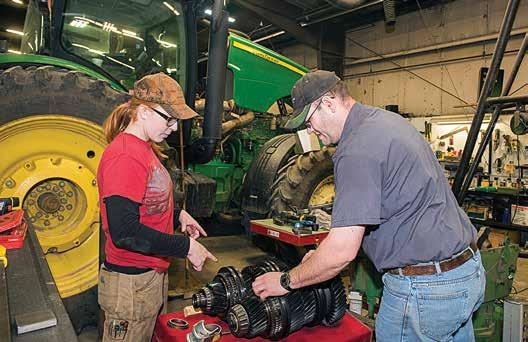Farming still runs in the family
Despite all the talk of factory farms, statistics show there are still a lot of family trees in farm fields Story by Martha Blum AgriNews Publications/ Shaw Media
KANSAS CITY, Mo. — Family farms represent 98 percent of all farms and 88 percent of production in the United States. Those numbers are included in the “America’s Diverse Family Farms — 2019 Edition” report which describes characteristics of the 2 million farms. “The report includes what the farms produce, farm profitability, receipts of government payments and participation in agricultural federal programs, which is important to understanding the farm sector,” said Christine Whitt, agricultural economist for the U.S. Department of Agriculture’s Economic Research Service (ARMS). The data included in this report was collected in the 2018 Agricultural Resource Management Survey. “ARMS is USDA’s primary source of information on
farm businesses and associated household principal operators,” Whitt said. “Principal operators are those who are most responsible for running the farm.” USDA defines a farm as any place that sold at least $1,000 worth of farm products in a given year. “The farm sector consists of a wide variety of farms — very small farms with little sales, mid-size farms with hundreds of thousands of dollars worth of sales and large farms with millions of dollars of sales,” Whitt said. “A family farm is any farm where more than 50 percent of the business is owned and operated by an operator and individuals related to one operator,” Whitt said. “The majority of farms are small family farms, but largescale farms have the largest share of the value of production,” Whitt said. “Small farms represent 90 percent of all farms, 48 percent of acres operated and 21 percent of production, whereas largescale family farms represent 2.7 percent of farms, but account for the largest share of production, at 45.4 percent on 19.5 percent total acres operated.” Small farms produce 56 percent of poultry production, which includes eggs, as well as 50 percent of the U.S. hay production. “Midsize and large family farms account for the majority of cotton, cash grains and
“Protecting Your Investment In Farmland” SM
oilseed production,” Whitt said. “Large-scale family farms produce the majority of dairy, and non-family farms and large-scale farms produce the bulk of high value crops and beef.” Many family households combine farm and off-farm income. “Over 41 percent of U.S. family farmers fall into the off-farm occupation typology class and over 80 percent of those operators work off farm as do 60 percent of their spouses,” Whitt said. “Principle operators of large-scale family farms are less likely to work off the farm than operators of small and midsize family farms — 11 percent of principal operators of large farms and 3 percent of very large farms held offfarm jobs,” Whitt said. “The majority of spouses of principal operators reported health care benefits are one
SERVING ALL PRODUCTION AGRICULTURE NEEDS
815-875-2800 Seed & Agronomy – Ashton, Buda, Henry, LaMoille, Ohio, Princeton, Toulon, Varna, Walnut, Walton Energy – Amboy, Buda, Henry, Princeton, Toulon, Varna, Wyoming Structures & Equipment – Princeton Technology & Precision Ag – Princeton Trucking & On Farm Delivery – Buda
SM-PR1747829
Douglas D. Ray, AFM Accredited Farm Manager/Managing Real Estate Broker
22
815-872-FARM (3276)
P.O. Box 39 • 226 Prairie Ln. W. • Princeton, IL 61356 www.rayfarm1.com • Email: rayfarm1@comcast.net
s p r i n g
2 0 2 0
of the reasons for working off the farm,” Whitt said. Occupations of operators who work off the farm are different from the general U.S. workforce. “Among operators of commercial and intermediate farms who also hold an offfarm job, 15 percent to 18 percent are working in farming, fishery or forestry occupations compared to 1 percent of the U.S. workforce,” Whitt said. “In general, farm operators are more likely to work in goods-producing occupations and less likely to work in service occupations.” Most payments from commodity related and working land conservation programs go to three groups — moderate sales, midsized and large farms, representing 76 percent working and 72 percent commodity-related payments, Whitt said.
SM-PR1427097








